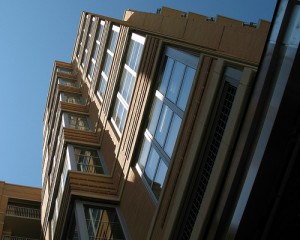Gentrifying with “Towers”– and How They Fail in Columbia Heights
“the part that really stood out to me was this graphic…outlining where Lydia thinks the height restrictions should be lifted…Anyone familiar with DC geography will notice that the area most insulated from change – Northwest DC – is the richest part of town, full of desirable white neighborhoods. The areas where DePillis advocates lifting the height limit – neighborhoods east of the Anacostia River figure prominently in the graphic – are far blacker and poorer than the rest of DC…
But still, the fact that the only incremental steps towards redensification we can take will disproportionately displace black families is something that should be recognized and discussed. If upzoning poor neighborhoods is the only way to get the city to allow dense development, then so be it, but we shouldn’t pretend that these sorts of half-measures won’t have consequences.
Lydia DePillis in the past has taken the position that gentrification is too often used to stymie useful development, which I definitely think is true. But we should also recognize that the way we’ve been upzoning cities in the last few decades has definitely encouraged the sort of radical gentrification that pushes blacks out of their neighborhoods. Anti-density zoning in the long term has been shown to cause racial segregation, but there can be no doubt that allowing condo towers along a streetcar route on Benning Road will price blacks out of the neighborhood in a way that could be mitigated if Glover Park, Columbia Heights, and Dupont Circle also had to accept a few towers of their own.
I live in the closest thing Columbia Heights currently has to a tower and the one thing I will say is that even though my building is a mere seven-stories-tall, both of the streets it sits on are already thick with congestion. Exiting the parking garage requires traveling down a narrow alley that almost never allows for two-way traffic because it is perpetually blocked by illegally-parked cars and trucks which are either delivering goods to the loading areas for Commonwealth Gastropub, Pete’s New Haven and the other businesses here– or getting ready to deliver the finished foods from those restaurants to hungry customers. Residents or restaurant employees who try to enter the alley to access the garage end up blocking an extremely busy sidewalk as they wait for an automobile traveling in the opposite direction to negotiate the various and haphazardly-ditched, blinking vehicles before making it to the edge of 14th street. Meanwhile, Metrobuses sweep in and away on 14th at full-speed, and crowds of people either bum rush the bus or scream profanity at the car which is inching through this morass. Poor planning is a charitable way to characterize the entire Charlie Foxtrot of a situation.
I love my building but it’s frustrating to enter or exit this area, whether you are a driver, a biker, a skater or a walker. I haven’t bothered telling you about the entitled dunces who illegally park in front of the alley’s driveway while they wait for someone, and sit there as if they can’t comprehend the English language, dramatic gestures or insistent horns, blocking everyone (WMATA, delivery truck, restaurant worker and resident alike), all of whom then block 14th street. It’s not like putting an entrance on perma-clogged Irving street would’ve been wiser, either. I’m not sure if Dupont Circle would be any different. These areas are already congested; that may be the reason why Lydia DePillis advocated lifting the height limits elsewhere– it may be an issue of space, not race. Columbia Heights had more of a chance than Dupont did, but it feels like for this particular block of the neighborhood, that moment has passed. For the entire year that I’ve lived here, one of the two streets I live on has been under construction, bringing movement to a crawl. Now that the equipment and orange-vested workers are gone…it’s only a little more bearable.
Having said that, I think the points that Smith makes are important ones– but maybe the best thing we could do for Benning Road is give it the gift of good planning, so that none of its intersections resemble the curse of 14th and Irving Streets, NW. Ideally, we should all walk, bike or use public transportation, but people who live in these dense apartment buildings often have cars, and while some may see the situation I described as something to gloat over, because they hope it will encourage alternate methods of traveling, it’s unrealistic to expect everyone who would move to one of these towers to sell their car before doing so. More sobering and worrisome than that, it’s only a matter of time before someone is struck or harmed, in the chaos of hundreds of people, all trying to occupy the same spot on a busy city block. That’s what a seven-story building has done. What would happen if it were 17 stories? It’s unfair to shovel change towards the poorest parts of this city– I’m not denying that. What I am questioning is whether D.C. can bear more intersections like the one I dodge and weave through, daily.







